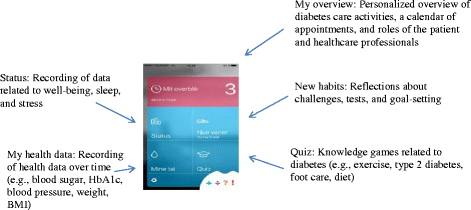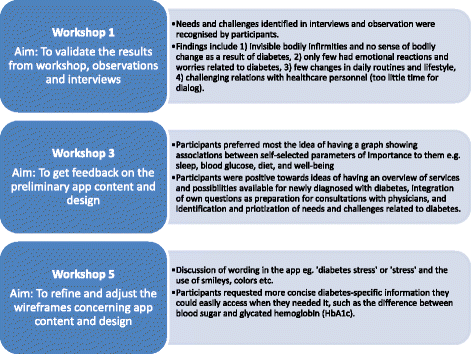Development and testing of a mobile application to support diabetes self-management for people with newly diagnosed type 2 diabetes: a design thinking case study
- PMID: 28651639
- PMCID: PMC5485734
- DOI: 10.1186/s12911-017-0493-6
Development and testing of a mobile application to support diabetes self-management for people with newly diagnosed type 2 diabetes: a design thinking case study
Erratum in
-
Erratum to: development and testing of a mobile application to support diabetes self-management for people with newly diagnosed type 2 diabetes: a design thinking case study.BMC Med Inform Decis Mak. 2017 Sep 12;17(1):133. doi: 10.1186/s12911-017-0525-2. BMC Med Inform Decis Mak. 2017. PMID: 28899375 Free PMC article. No abstract available.
Abstract
Background: Numerous mobile applications have been developed to support diabetes-self-management. However, the majority of these applications lack a theoretical foundation and the involvement of people with diabetes during development. The aim of this study was to develop and test a mobile application (app) supporting diabetes self-management among people with newly diagnosed type 2 diabetes using design thinking.
Methods: The app was developed and tested in 2015 using a design-based research approach involving target users (individuals newly diagnosed with type 2 diabetes), research scientists, healthcare professionals, designers, and app developers. The research approach comprised three major phases: inspiration, ideation, and implementation. The first phase included observations of diabetes education and 12 in-depth interviews with users regarding challenges and needs related to living with diabetes. The ideation phrase consisted of four interactive workshops with users focusing on app needs, in which ideas were developed and prioritized. Finally, 14 users tested the app over 4 weeks; they were interviewed about usability and perceptions about the app as a support tool.
Results: A multifunctional app was useful for people with newly diagnosed type 2 diabetes. The final app comprised five major functions: overview of diabetes activities after diagnosis, recording of health data, reflection games and goal setting, knowledge games and recording of psychological data such as sleep, fatigue, and well-being. Users found the app to be a valuable tool for support, particularly for raising their awareness about their psychological health and for informing and guiding them through the healthcare system after diagnosis.
Conclusions: The design thinking processes used in the development and implementation of the mobile health app were crucial to creating value for users. More attention should be paid to the training of professionals who introduce health apps.
Trial registration: Danish Data Protection Agency: 2012-58-0004. Registered 6 February 2016.
Keywords: Design thinking; Diabetes self-management; Diabetes support; Mobile application; Qualitative methods; Type 2 diabetes.
Conflict of interest statement
Author’s information
MMPR: Candidate in Master of Science (MSc) in Health Promotion and Strategies and Educational Studies and research assistant at Diabetes Management Research, Steno Diabetes Center Copenhagen. NFHR: Candidate in Master of Science in Public Health, University of Copenhagen, PhD, and senior researcher at Diabetes Management Research, Steno Diabetes Center Copenhagen
Ethics approval and consent to participate
All users were informed of the aim of the study and gave their written consent to participate. The study was conducted in compliance with the Helsinki Declaration and was approved by the Danish Data Protection Agency (2012-58-0004) and processed by the National Committee on Health Research Ethics (16048960).
Consent for publication
Not applicable.
Competing interests
The authors declare that they have no competing interests.
Publisher’s Note
Springer Nature remains neutral with regard to jurisdictional claims in published maps and institutional affiliations.
Figures
Similar articles
-
Mobile-Based and Cloud-Based System for Self-management of People With Type 2 Diabetes: Development and Usability Evaluation.J Med Internet Res. 2021 Jun 2;23(6):e18167. doi: 10.2196/18167. J Med Internet Res. 2021. PMID: 34076579 Free PMC article.
-
Users' acceptability of a mobile application for persons with type 2 diabetes: a qualitative study.BMC Health Serv Res. 2019 Sep 6;19(1):641. doi: 10.1186/s12913-019-4486-2. BMC Health Serv Res. 2019. PMID: 31492176 Free PMC article. Clinical Trial.
-
The development of My Care Hub Mobile-Phone App to Support Self-Management in Australians with Type 1 or Type 2 Diabetes.Sci Rep. 2020 Jan 8;10(1):7. doi: 10.1038/s41598-019-56411-0. Sci Rep. 2020. PMID: 31913296 Free PMC article.
-
Rapid Evidence Review of Mobile Applications for Self-management of Diabetes.J Gen Intern Med. 2018 Jul;33(7):1167-1176. doi: 10.1007/s11606-018-4410-1. Epub 2018 May 8. J Gen Intern Med. 2018. PMID: 29740786 Free PMC article. Review.
-
What are the perceptions and experiences of adults using mobile applications for self-management in diabetes? A systematic review.BMJ Open. 2025 Jan 20;15(1):e086671. doi: 10.1136/bmjopen-2024-086671. BMJ Open. 2025. PMID: 39833008 Free PMC article.
Cited by
-
A qualitative study of users' experiences after 3 months: the first Rwandan diabetes self-management Smartphone application "Kir'App".Ther Adv Endocrinol Metab. 2020 Apr 27;11:2042018820914510. doi: 10.1177/2042018820914510. eCollection 2020. Ther Adv Endocrinol Metab. 2020. PMID: 32523670 Free PMC article.
-
Mobile Applications for Multiple Sclerosis: a Focus on Self-Management.Acta Inform Med. 2019 Mar;27(1):12-18. doi: 10.5455/aim.2019.27.12-18. Acta Inform Med. 2019. PMID: 31213737 Free PMC article.
-
Collaboratively Designing an App for a More Personalized, Community-Endorsed Continuous Glucose Monitoring Onboarding Experience: An Early Study.J Diabetes Sci Technol. 2024 Jan;18(1):14-21. doi: 10.1177/19322968231213654. Epub 2023 Nov 18. J Diabetes Sci Technol. 2024. PMID: 37978817 Free PMC article.
-
Development and Testing Requirements for an Integrated Maternal and Child Health Information System in Iran: A Design Thinking Case Study.Methods Inf Med. 2022 Dec;61(S 02):e64-e72. doi: 10.1055/a-1860-8618. Epub 2022 May 24. Methods Inf Med. 2022. PMID: 35609871 Free PMC article.
-
The Application of Human-Centered Design Approaches in Health Research and Innovation: A Narrative Review of Current Practices.JMIR Mhealth Uhealth. 2021 Dec 6;9(12):e28102. doi: 10.2196/28102. JMIR Mhealth Uhealth. 2021. PMID: 34874893 Free PMC article. Review.
References
-
- International Diabetes Foundation (IDF) IDF diabetes atlas. 7. Brussels: IDF; 2015.
-
- IDF. Global guideline for type 2 diabetes. 2012. https://www.idf.org/e-library/guidelines/79-global-guideline-for-type-2-.... Accessed 13 Feb 2017.
Publication types
MeSH terms
LinkOut - more resources
Full Text Sources
Other Literature Sources
Medical



